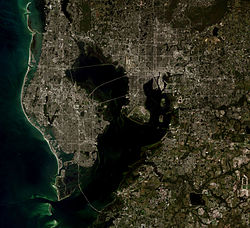
The Tampa Bay area has a humid subtropical climate (Köppen Cfa), closely bordering a tropical climate near the waterfront areas. There are two basic seasons in the Tampa Bay area, a hot and wet season from May through October, and a mild and dry season from November through April.
Nearly two-thirds of the annual precipitation falls in the months of June through September. The area is listed by the United States Department of Agriculture (USDA) as being in hardiness zone 10a as well as hardiness zone 10b along the immediate coast and in peninsular Pinellas;[1] which is about the northern limit of where coconut palms and royal palms can be grown. Highs usually range between 65 and 95 °F (18–35 °C) year round. Tampa's official high has never reached 100 °F (38 °C) – the city's all-time record temperature is 99 °F (37 °C). St. Petersburg's all-time record high is exactly 100 °F (38 °C).[2]
Pinellas County lies on a peninsula between Tampa Bay and the Gulf of Mexico, and much of the city of Tampa lies on a smaller peninsula jutting out into Tampa Bay. This proximity to large bodies of water both moderates temperatures and introduces large amounts of humidity into the atmosphere. In general, the local communities farthest from the coast have larger temperature ranges, both during a single day and throughout the seasons of the year.[3]
- ^ "Interactive Map - USDA Plant Hardiness Zone Map". USDA Agricultural Research Service. USDA. Archived from the original on 2019-07-04. Retrieved 2021-05-08.
- ^ Tampa Weather Forecasts on Yahoo! Weather Archived December 16, 2008, at the Wayback Machine. Weather.yahoo.com. Retrieved on 2009-02-06.
- ^ Cite error: The named reference
gainesville2003was invoked but never defined (see the help page).
